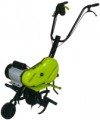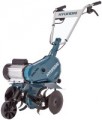Working depth
The maximum processing depth provided by the unit. In cultivators with non-replaceable cutters, this parameter is determined primarily by the cutter diameter, in walk-behind tractors designed for active cutters (see below) - by design features (in such models, even high power does not guarantee a large working depth). The most limited indicator in modern walk-behind tractors is
up to 20 cm, and a value
from 21 to 25 cm can be called small. However, often even such capabilities are quite sufficient. A depth of
26 to 30 cm already provides quite extensive capabilities, and the most advanced models are capable of "biting into the ground"
more than 30 cm.
In any case, the optimal processing depth depends on the type and condition of the soil, as well as the crops for which the soil is being prepared; detailed recommendations on this matter can be found in specialized sources. So it does not always make sense to look for a model with maximum depth - especially since such capabilities require high power. It should also be noted that in many units the depth can be adjusted.
Design
—
Power take-off shaft. The presence of a power take-off shaft in the design of a two-wheel tractor. Such a shaft provides the transmission of rotation from the engine to additional equipment used with a two-wheel tractor — seeders, mowers, mulchers, harvesters and other units that require a mechanical drive for operation. Thus, this function significantly expands the capabilities of the two-wheel tractor and the range of equipment compatible with it. On the other hand, it complicates the design, increases its weight, and most importantly, the price. It is also worth considering that different external units may have different types of tails for the power take-off shaft and different requirements for rotation speed; compatibility on these points must be clarified separately.
—
Power take-off pulley. The function is similar to that described above — the power take-off shaft. A distinctive feature is its location and, accordingly, the method of hanging additional equipment. The shaft is located behind the rear end, while the pulley is on the side of the housing.
—
Transport wheels. The presence in the design of the cultivator / two-wheel tractor of a special wheel (wheels), facilitating the transportation of the unit during non-working hours. In cultivators, such wheels allow you not to drag the device directly on the ground (which can damage the working tool) or
...in your hands (which is inconvenient due to the large weight), and in two-wheel tractors they provide an additional point of support for both moving and parking. These wheels should not be confused with the main wheels of the device: the unit moves to the main wheels during operation (and in many models — all the time), while the transport wheels are used exclusively during non-working hours.
— Reverse. The possibility of moving the unit in reverse — for this, the direction of rotation of the wheels or the cutter is reversed. This function gives additional features for manoeuvring; it is especially useful in heavy equipment that would be inconvenient to pull on yourself manually.
— Differential lock. The ability to turn off the differential in the two-wheel tractor is a special mechanism designed to “coordinate” the movement of the wheels with each other when turning. The differential is necessary for normal handling on relatively flat ground, but it worsens the overall patency — these are the technical features of the mechanism. Therefore, in some two-wheel tractors, it may be possible to block the differential; this can be useful both in rough terrain and in some jobs with high and uneven wheel loads.
— Protections for plants. Special devices, also called "cutting guards". They usually look like two metal discs on either end of the axle where the cutters are located. These discs prevent plants from getting into the working tool and allow you to work the land in the immediate vicinity of already planted plants without fear of damaging them with the cultivator's cutters. You should definitely pay attention to the presence of such protection if you are going to use the device for inter-row cultivation.
— Height adjustable handle. The ability to change the height at which the handles of the two-wheel tractor are located. This feature is designed to adjust the handles to the height of the operator — for people of different heights, the most comfortable height will also be different.
— Lateral rotation of the handle. The ability to turn the handle of the two-wheel tractor to the side — so that the operator can go not behind the unit, but next to it. This function will be useful in cases where it is inconvenient or undesirable for the user to be behind the two-wheel tractor — for example, if it is impossible to trample on cultivated land, if the applied nozzle throws soil or grass back, or if this nozzle protrudes strongly backwards, and because of it it is not up to the handles reach out.
— Headlights. The presence of headlights will allow you to work with a cultivator / two-wheel tractor, regardless of the time of day and external light sources — in the dark, just turn on the headlights. They may also be required when using a two-wheel tractor as a tractor — both at night, and in some other cases provided for by traffic rules.Noise level
The maximum noise level produced by the cultivator / two-wheel tractor during operation. A noise of 70 dB is comparable to a very loud conversation, 80 dB to a busy city street, 100 dB to a production shop. The lower the noise level, the more comfortable the use of the unit for the operator himself and the less inconvenience it causes to others.

